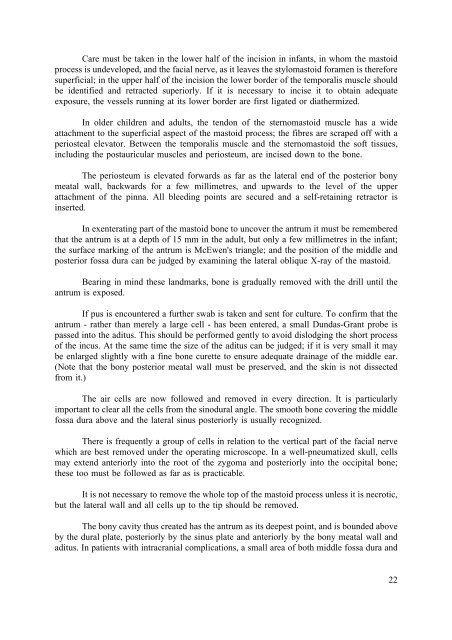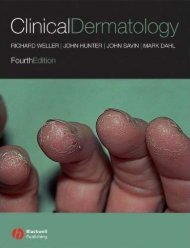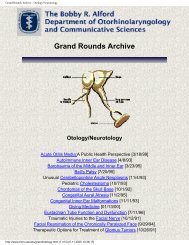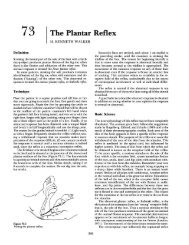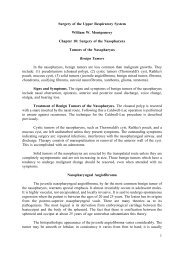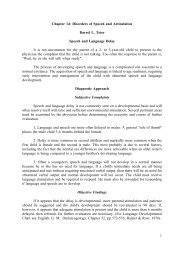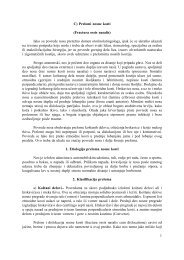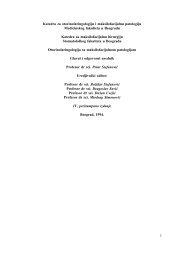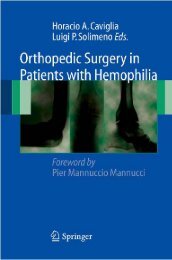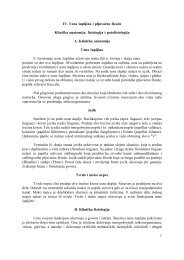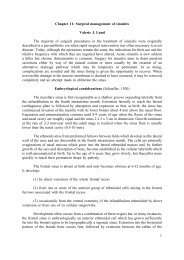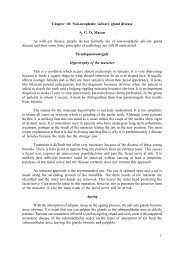1 Chapter 13: Acute suppurative otitis media and acute mastoiditis ...
1 Chapter 13: Acute suppurative otitis media and acute mastoiditis ...
1 Chapter 13: Acute suppurative otitis media and acute mastoiditis ...
You also want an ePaper? Increase the reach of your titles
YUMPU automatically turns print PDFs into web optimized ePapers that Google loves.
Care must be taken in the lower half of the incision in infants, in whom the mastoid<br />
process is undeveloped, <strong>and</strong> the facial nerve, as it leaves the stylomastoid foramen is therefore<br />
superficial; in the upper half of the incision the lower border of the temporalis muscle should<br />
be identified <strong>and</strong> retracted superiorly. If it is necessary to incise it to obtain adequate<br />
exposure, the vessels running at its lower border are first ligated or diathermized.<br />
In older children <strong>and</strong> adults, the tendon of the sternomastoid muscle has a wide<br />
attachment to the superficial aspect of the mastoid process; the fibres are scraped off with a<br />
periosteal elevator. Between the temporalis muscle <strong>and</strong> the sternomastoid the soft tissues,<br />
including the postauricular muscles <strong>and</strong> periosteum, are incised down to the bone.<br />
The periosteum is elevated forwards as far as the lateral end of the posterior bony<br />
meatal wall, backwards for a few millimetres, <strong>and</strong> upwards to the level of the upper<br />
attachment of the pinna. All bleeding points are secured <strong>and</strong> a self-retaining retractor is<br />
inserted.<br />
In exenterating part of the mastoid bone to uncover the antrum it must be remembered<br />
that the antrum is at a depth of 15 mm in the adult, but only a few millimetres in the infant;<br />
the surface marking of the antrum is McEwen's triangle; <strong>and</strong> the position of the middle <strong>and</strong><br />
posterior fossa dura can be judged by examining the lateral oblique X-ray of the mastoid.<br />
Bearing in mind these l<strong>and</strong>marks, bone is gradually removed with the drill until the<br />
antrum is exposed.<br />
If pus is encountered a further swab is taken <strong>and</strong> sent for culture. To confirm that the<br />
antrum - rather than merely a large cell - has been entered, a small Dundas-Grant probe is<br />
passed into the aditus. This should be performed gently to avoid dislodging the short process<br />
of the incus. At the same time the size of the aditus can be judged; if it is very small it may<br />
be enlarged slightly with a fine bone curette to ensure adequate drainage of the middle ear.<br />
(Note that the bony posterior meatal wall must be preserved, <strong>and</strong> the skin is not dissected<br />
from it.)<br />
The air cells are now followed <strong>and</strong> removed in every direction. It is particularly<br />
important to clear all the cells from the sinodural angle. The smooth bone covering the middle<br />
fossa dura above <strong>and</strong> the lateral sinus posteriorly is usually recognized.<br />
There is frequently a group of cells in relation to the vertical part of the facial nerve<br />
which are best removed under the operating microscope. In a well-pneumatized skull, cells<br />
may extend anteriorly into the root of the zygoma <strong>and</strong> posteriorly into the occipital bone;<br />
these too must be followed as far as is practicable.<br />
It is not necessary to remove the whole top of the mastoid process unless it is necrotic,<br />
but the lateral wall <strong>and</strong> all cells up to the tip should be removed.<br />
The bony cavity thus created has the antrum as its deepest point, <strong>and</strong> is bounded above<br />
by the dural plate, posteriorly by the sinus plate <strong>and</strong> anteriorly by the bony meatal wall <strong>and</strong><br />
aditus. In patients with intracranial complications, a small area of both middle fossa dura <strong>and</strong><br />
22


